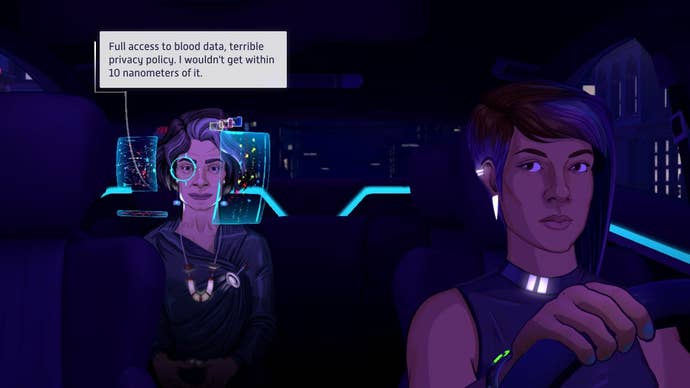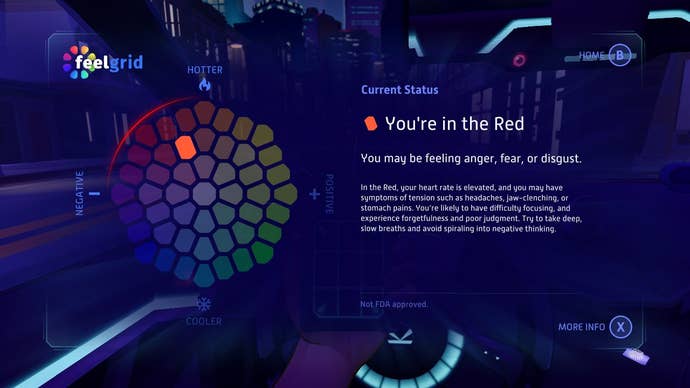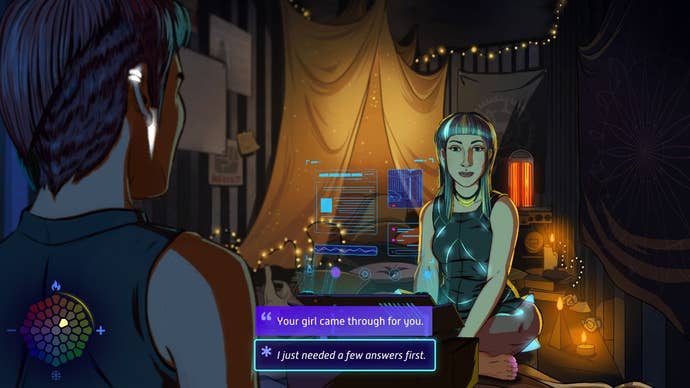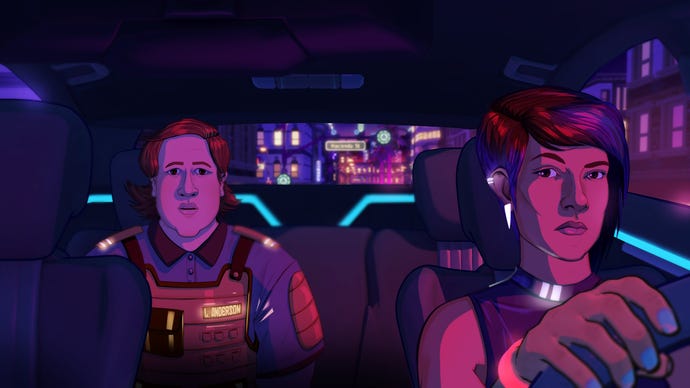Inside Neo Cab, the "Nowpunk" Noir Indie That Is One of 2019's Most Underrated Games
We speak with Chance Agency's Patrick Ewing about the twists and turns of the studio's "Nowpunk" noir.
This article first appeared on USgamer, a partner publication of VG247. Some content, such as this article, has been migrated to VG247 for posterity after USgamer's closure - but it has not been edited or further vetted by the VG247 team.
Carol Reed's 1949 noir classic The Third Man tells the story of Holly Martins, an American in post-war Vienna who finds himself tumbling into a web of intrigue. The city, divvied up into districts overseen by the Soviet Union, Great Britain, France, and the United States, has no place for naivety. At first thinking he's there to pursue an opportunity given by his old friend Harry Lime, Martins' plans are quickly waylaid. Lime is believed dead.
When Patrick Ewing, creative director of Chance Agency, tells me that studio's first game Neo Cab takes inspiration from The Third Man, the connections instantly snap into focus. Neo Cab follows Lina Romero, one of the last remaining human drivers for the eponymous gig cab service. In the near-future city of Los Ojos, California, self-driving cars operated by the mega-corp Capra, Lina's former cab employer, have all but taken over. Lina goes there to move in with her longtime friend Savy and start a new life, but Savy goes missing right as Lina learns Los Ojos is days away from a vote that could ban human drivers outright. Alone and untethered, Lina has to make connections with her passengers, piece together what happened to Savy, and survive.
"It was actually our writer Duncan Fyfe who told me to watch The Third Man," says Ewing. "I think he was just like, 'this sounds a lot like the city that we're describing.'" Indeed, Neo Cab's "Nowpunk" noir summons up a similar kind of intrigue. Replace the occupying allied forces with corporations and the fallout of World War 2 with the decay of tech accelerationism and there you have it. Like Reed's film, however, Neo Cab never loses sight of Lina—and, by extension, Savy—to tell the story of a city and a society. Neo Cab tackles its bigger concepts while never straying far from the personal relationship at its core.

"I think we kind of knew from the beginning that that's the sort of story we wanted to do," Ewing says. "We wanted the elements of a bigger city and a conflict that's a bit out of your range as a person to sway in any way."
By the end of the story, I found myself far more invested in Lina's individual fate than in that of the world she finally gets a shot at nudging in a new direction. That's why I wanted to talk to someone from Chance Agency; Neo Cab doesn't serve up a hodgepodge of neon, noir, and dystopia. It communicates its world and ideas through an intimate, nearly static frame. It paints pictures of complex human relationships almost entirely by way of having two or three people talk and feel their feelings in cab rides.
Spoiler Warning: This piece goes deep on the story of Neo Cab and gives away some details as to how the game ends.
All Eyes on Your Innermost Thoughts
Neo Cab touches on all the themes the term "late capitalism" evokes: surveillance, alienation, political unrest, mental and emotional distress. That last point is a central mechanic in Neo Cab. Early on, Lina's given a Feelgrid, a Fitbit-like mood ring that displays Lina's approximate emotional state as a color on a "circumplex." Red is angry or anxious, yellow's hyper or cheerful, blue's lethargic or depressed, and green is calm or chill. In conversations with passengers, Lina's emotional state changes—let it go too far in an extreme, and you may lose or gain access to certain dialogue options.
While playing, I figured there was a bit of smoke and mirrors going on with the Feelgrid. I wondered if certain dialogue options were never intended to be accessible, that you'd always be nudged into an extreme that prevented access. I was wrong. "In most cases, if an option is disabled to you because of your Feelgrid, there is a path where that same option would be possible," Ewing tells me. "You just have to get Lina into the best place."

That wasn't terribly easy to do at points throughout Neo Cab's story. With Savy missing, no apartment to crash in at the end of the night, and obnoxious passengers in my car, Lina's more annoyed responses often felt like the way to go. As I progressed, that feeling changed. The things Lina could or couldn't say stopped feeling like "options" in a list so much as a look inside her mind—like they're all thoughts Lina's having simultaneously, but only one will win out. Dialogue choices in games rarely feel like they encapsulate a cohesive inner monologue, and I can't think of any that have done so as effectively as Neo Cab.
Given that Neo Cab plays a lot like a visual novel, you may be surprised to hear Bloodborne influenced its emotion system. "I loved that there was this in-game currency called Insight, which was a number that went up, and so people would tend to hoard it," explains Ewing. "Narratively, it represents your awareness of the cosmic horror of the universe. So if you don't spend it—if you let it keep growing—the world gets corrupted around you. [...] My inspiration from Bloodborne was the idea that sometimes, character attributes can be good in some contexts and really bad in others."
So, on top of managing Lina's meager funds and her electric car's charge, players need to pay attention to what Lina's emotions are and how she might be better off feeling. "Early on, we had two separate attributes that could be positive or negative," Ewing says. "'Faith' was the one we could kind of use like Insight, like your faith in humanity." The other was "Energy," a measure of how Lina felt in her body. After reading Lisa Feldman Barrett's "How Emotions Are Made" and discovering the circumplex model of emotion, Ewing and the Chance Agency team had their breakthrough for the Feelgrid and how to link Lina's emotions and dialogue.
"Essentially, we just adapted that system we had before which was 'Energy' and 'Faith' into this cohesive 2D map," says Ewing. "It really felt like, as soon as we got that, it was like 'oh, it all makes sense, we can write dialogue for this full spectrum of emotions and let the player's imagination fill in specific gaps.' The game is telling you Lina is this red, she's this far away from the edge, but you as the player get to decide, like, is she angry? Is she scared? Is she anxious? The red spectrum can catch all of those things."
As I got more in tune with Lina's struggles and adjusted to Neo Cab's rhythms, sometimes it still felt right for Lina to be out in the red, but I stopped trying to push or pull her in a direction. Instead of thinking "what should or would Lina do here," I asked, "how do I think Lina feels, and what do I think she wants to say?"
The Struggle and Savy
Shortly after Lina arrives in Los Ojos, Savy goes missing. Lina scarcely has time to say "hello" and start reminiscing with her old friend before she has to start piecing together what happened to her in an unfamiliar city.
Along the way, you take in all manners of people in your car—I could go on and on about the quantum hacker, the techies on a terrible first date, the cultist who worships a pain worm, and more. One in particular, Azul, stands out because they enter Lina's car uninvited to make a quick escape from an anti-Capra demonstration gone awry. On top of that, Azul really doesn't want to be in a cab: they're a member of Radix, a cyclist-led activist group that opposes the overreach of both Capra and car infrastructure, period.
Azul's introduction teaches players about the Feelgrid and digs into the politics of Los Ojos, but it focuses on the tension between Lina and this stranger. "We definitely heard some folks say that they weren't perfectly aligned with Lina in the Azul ride, because they would be more charitable to someone jumping in the car under these circumstances, for political reasons and for just helping a human," says Ewing. "That incident, where Lina's literally triggered by a stranger jumping into her car, was really important for that reason, I think. It's not so much that we want you to politically, immediately align or be against Radix, it's much more that we want you to really see what Lina's like when something crosses a boundary for her."
Having been a bike commuter myself, the part of me that wanted to play as if I were Lina would've abandoned the car and joined Radix if the option was available. Realistically, though, that's not a choice Lina could or would make. She needs the money from cabbing, and picking up fares is her best shot for finding Savy—who, you find out, needs a lot from Lina.
You learn Savy herself was caught up between Capra and Radix, which means Lina needs to navigate the conflict in her search for her friend. "Lina's stuck in between this megacorp that is truly soulless, fired her, and seems to be upending the economy on one side, and then these purist, anarchistic folks who hate her just because of her job on the other side," Ewing says. "That dynamic, I think, makes the politics of the game more interesting, and also gives the player a little bit of a chance to pick sides and to feel which way they're leaning, when it's not just 'which one of these parties is actually a friend,' because neither really is."
Talking Through Toxicity
After a week of cabbing and sleuthing, Lina finds out Savy's been working on a plan to strike at Capra—one that Lina's been an unwitting participant in. The reveal of Savy's scheme and how she went about pulling it off is Neo Cab's climax. It's also where the influence of The Third Man shines most, and when the emotion mechanics come into clearest focus. Early on in Neo Cab, Lina is worried about seeing Savy again, about how they left their relationship when Savy went to Los Ojos. By the story's end, it's obvious why—Savy is revealed to be manipulative as all hell. The fate of the city hinges on whether Lina falls back into an unhealthy dynamic with Savy, or takes a stand.

Like with Harry Lime and Molly Martins in The Third Man, Savy's disappearance is a means for setting Lina up. Neo Cab, though, layers in enough of the history between Lina and Savy to make that betrayal not only feel inevitable, but to have it cut deep. Ewing says the Chance Agency writing team pulled from their own experiences to present their depiction of a toxic relationship.
"'Missing best friend' was the beginning part, and especially then that discovery of 'oh, my friend who set all this in motion, in many ways abandoned me and is kind of a horrible person,' and was so compelling," says Ewing. "I think, for [story editor Paula Rogers] and I, we both have had very close friendships like that. Specifically, the dynamic of a friend who is larger than life and who is sort of, when you're on her good side she makes you feel like you're the coolest person in the world, but the minute you're not playing along with her game she's gonna make you feel like s**t and that you're the worst friend ever."
There's a moment toward the end of Neo Cab that plays out between Lina and Savy that Ewing refers to in our talk as a "boss battle," and to me it felt achingly true-to-life. "Those were the pieces that snapped into place, and suddenly we had all this material of toxic friendships," Ewing says. "I'm remembering now all these moments in the writer's room, where [writer] Kim Belair would say something that her ex had said to her, y'know."
I would've walked away from my time with Neo Cab happy if I'd gotten a Blade Runner-ish take on Taxicab Confessions with some insights on gig labor, but the dynamic between Lina and Savy is ultimately what resonated most with me. If I were to recommend it to a friend, I'd say Neo Cab's worth playing to see exactly that—even though (or rather, because) it can be a painful thing to watch Lina grapple with.
"For us, the beginning part of the game needs to be carried by the idea that you are actually concerned about Savy and want her to be okay," Ewing explains. "'That's the bait' was our hope." Lina, who stakes her livelihood on Savy, falls for the act hook, line, and sinker. In playing through her experience, I got reeled in too.


